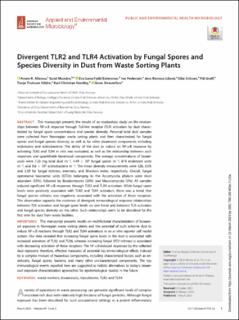| dc.description.abstract | This manuscript presents the results of an exploratory study on the relationships between NF-κB response through Toll-like receptor (TLR) activation by dust characterized by fungal spore concentrations and species diversity. Personal total dust samples were collected from Norwegian waste sorting plants and then characterized for fungal spores and fungal species diversity, as well as for other bioaerosol components, including endotoxins and actinobacteria. The ability of the dust to induce an NF-κB response by activating TLR2 and TLR4 in vitro was evaluated, as well as the relationship between such responses and quantifiable bioaerosol components. The average concentrations of bioaerosols were 7.23 mg total dust m−3, 4.49 × 105 fungal spores m−3, 814 endotoxin units m−3, and 0.6 × 105 actinobacteria m−3. The mean diversity measurements were 326, 0.59, and 3.39 for fungal richness, evenness, and Shannon index, respectively. Overall, fungal operational taxonomic units (OTUs) belonging to the Ascomycota phylum were most abundant (55%), followed by Basidiomycota (33%) and Mucoromycota (3%). All samples induced significant NF-κB responses through TLR2 and TLR4 activation. While fungal spore levels were positively associated with TLR2 and TLR4 activation, there was a trend that fungal species richness was negatively associated with the activation of these receptors. This observation supports the existence of divergent immunological response relationships between TLR activation and fungal spore levels on one hand and between TLR activation and fungal species diversity on the other. Such relationships seem to be described for the first time for dust from waste facilities. | |
